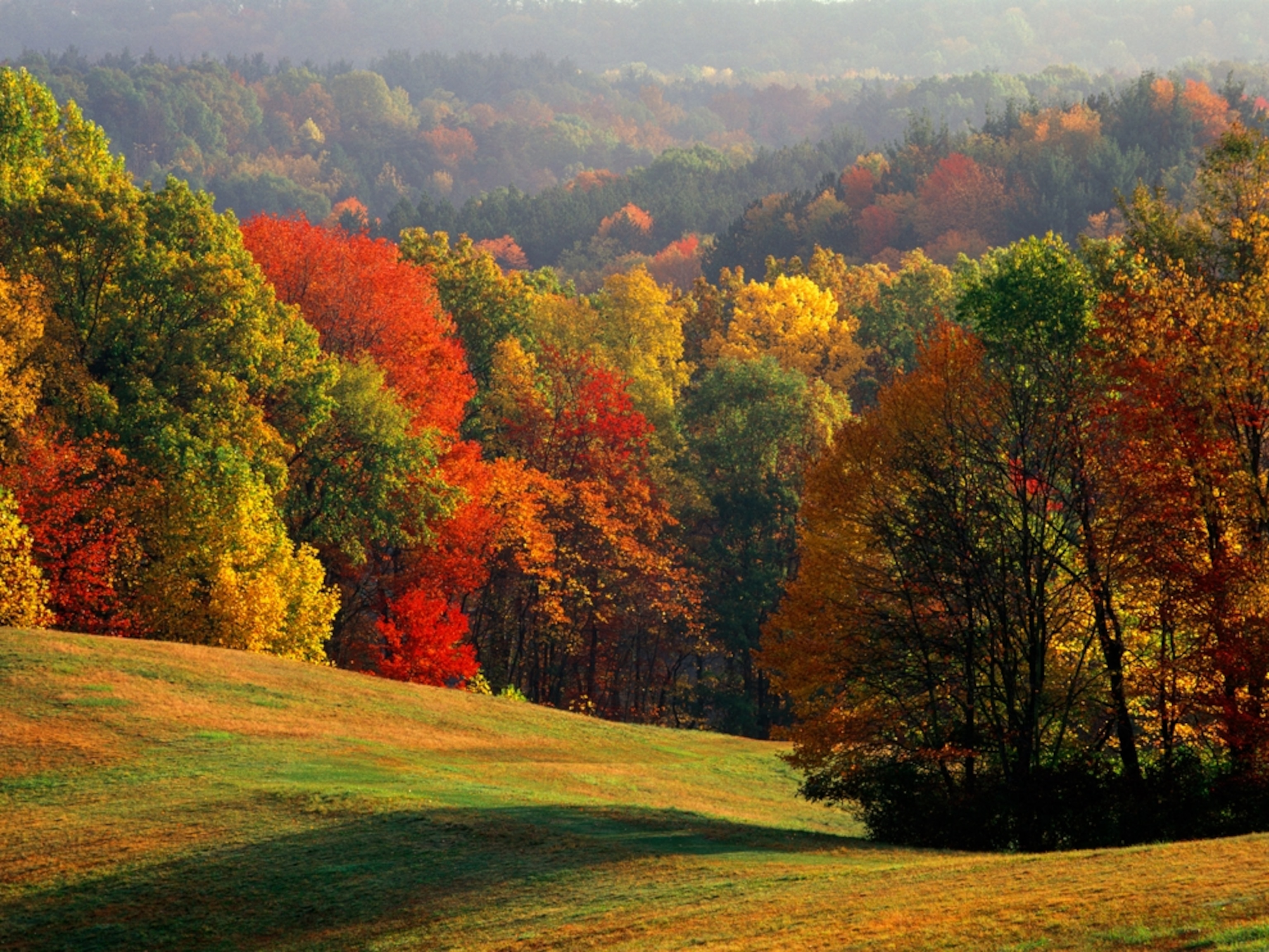









Cuyahoga Valley National Park
Location: Ohio
Established: October 11, 2000
Size: 33,000 acres
If there is one word that typifies Cuyahoga Valley, it might well be "surprise." To begin, many people are surprised by the simple fact that a national park exists in northeastern Ohio, between the sprawling cities of Cleveland and Akron. In fact, it hasn't existed for long: Cuyahoga Valley was given national park status only in 2000.
Visitors find more surprises: Secluded trails through rugged gorges that seem far removed from civilization; vistas of tree-covered hills where the urban world is out of sight; marshes where beaver, herons, and wood ducks thrive.
Crisscrossed by roads and freeways, encompassing towns, private attractions, and city parks, Cuyahoga Valley is hardly comparable to the vast western wilderness parks—a circumstance that leads to even more surprises. Visitors can ride a scenic railroad, hear a symphony concert, attend an art exhibit, play golf, or, in winter, zoom down snowy ski slopes.
The park's history is as unique as its potpourri of natural and manmade attractions. In the 1960s, local citizens and public officials became concerned that commercial and residential development was threatening the scenic Cuyahoga River Valley, with its villages, quiet byways, and forests. In 1974, Congress passed a bill creating a National Recreation Area, administered by the National Park Service. The park began acquiring private land within the designated 33,000 acres, as well as working out cooperative agreements with developments already in place, such as Cleveland and Summit County metropolitan park districts and Blossom Music Center, the summer home of the Cleveland Orchestra. Eventually, confusion about the meaning of "recreation area" led supporters to call for full national park status.
Today, Cuyahoga Valley National Park serves the metropolitan area in a multitude of ways. Residents jog, ride bicycles, or picnic in the park; local children ride sleds down its hills in winter; nature-lovers love its pockets of wild greenery, home to dozens of species of birds and wildflowers; fans of the arts watch Shakespeare and musicals at Kent State University's Porthouse Theatre. Cuyahoga Valley may not fit everyone's idea of a national park, but that doesn't tarnish the appeal of its many rewards.
How to Get There
From Cleveland, take I-77 15 miles south; from Akron, go 13 miles north on I-77 or Ohio 8; from the east or west, I-80 bisects the park, as does I-271. Airports: Cleveland or Akron.
When to Go
Year-round. Weekends can be crowded along the Towpath Trail from spring through fall, and especially in summer. Many activities are curtailed in winter, but downhill skiing, cross-country skiing, snowshoeing, and sledding are popular. Spring wildflowers and fall foliage make these especially colorful and appealing seasons.
How to Visit
Stop at the Canal Visitor Center for an overview of canal and valley history and information on park activities; ask about ranger-led tours and special events. Walk or bicycle a portion of the Towpath Trail before driving east to take in the beauty of Tinkers Creek Gorge. Then head south to see Brandywine Falls, continuing to the towns of Boston and Peninsula for museums and exhibits. Walk some of the scenic trails south of the Happy Days Lodge, especially in the area called The Ledges.
Related Topics
You May Also Like
Go Further
Animals
- How can we protect grizzlies from their biggest threat—trains?How can we protect grizzlies from their biggest threat—trains?
- This ‘saber-toothed’ salmon wasn’t quite what we thoughtThis ‘saber-toothed’ salmon wasn’t quite what we thought
- Why this rhino-zebra friendship makes perfect senseWhy this rhino-zebra friendship makes perfect sense
- When did bioluminescence evolve? It’s older than we thought.When did bioluminescence evolve? It’s older than we thought.
- Soy, skim … spider. Are any of these technically milk?Soy, skim … spider. Are any of these technically milk?
Environment
- Are the Great Lakes the key to solving America’s emissions conundrum?Are the Great Lakes the key to solving America’s emissions conundrum?
- The world’s historic sites face climate change. Can Petra lead the way?The world’s historic sites face climate change. Can Petra lead the way?
- This pristine piece of the Amazon shows nature’s resilienceThis pristine piece of the Amazon shows nature’s resilience
- Listen to 30 years of climate change transformed into haunting musicListen to 30 years of climate change transformed into haunting music
History & Culture
- Meet the original members of the tortured poets departmentMeet the original members of the tortured poets department
- Séances at the White House? Why these first ladies turned to the occultSéances at the White House? Why these first ladies turned to the occult
- Gambling is everywhere now. When is that a problem?Gambling is everywhere now. When is that a problem?
- Beauty is pain—at least it was in 17th-century SpainBeauty is pain—at least it was in 17th-century Spain
Science
- Here's how astronomers found one of the rarest phenomenons in spaceHere's how astronomers found one of the rarest phenomenons in space
- Not an extrovert or introvert? There’s a word for that.Not an extrovert or introvert? There’s a word for that.
- NASA has a plan to clean up space junk—but is going green enough?NASA has a plan to clean up space junk—but is going green enough?
- Soy, skim … spider. Are any of these technically milk?Soy, skim … spider. Are any of these technically milk?
Travel
- Dina Macki on Omani cuisine and Zanzibari flavoursDina Macki on Omani cuisine and Zanzibari flavours
- How to see Mexico's Baja California beyond the beachesHow to see Mexico's Baja California beyond the beaches
- Could Mexico's Chepe Express be the ultimate slow rail adventure?Could Mexico's Chepe Express be the ultimate slow rail adventure?




